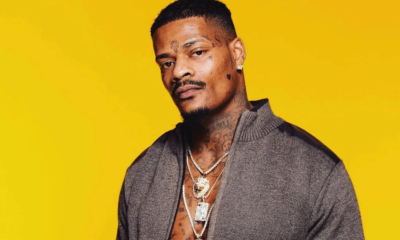Culture
The Rise of Princess Gollum: An Enigmatic Force in Fashion
Published
3 years agoon

Princess Gollum, a.k.a. Josephine Lee, has made waves in social media and fashion with her distinctive character and avant-garde style. Her media savvy and focus on the dark, chained, and unexpected have made her media curator alias, the dark empress, a self-made triumph. Numerous admirers have been won over by Princess Gollum’s juxtaposition of a sweet yet alluring angelic demeanor. Josephine was one of the industry’s most intriguing and unique names, and Flaunt Magazine had the pleasure of meeting up with her to learn more about her journey.
The Evolution of Princess Gollum
The road that Josephine took to become Princess Gollum was not an easy one. She underwent several identity changes before settling on her present persona. She first appeared as Babyalmondeyes, sporting pink fur-covered ensembles à la Cam’ron, bucket hats, and monochromatic sweatsuits. She had recently left college and returned home, feeling disoriented and unsure of what to do next.
She then changed into Wifislilangel, a ferocious persona with razor-sharp black cat-eye makeup, matching monochromatic sweatsuits, barbed wire, chains, and locks, among other fierce accessories. But when she understood that Wifislilangel was innocent and perhaps a little naïve, she experienced a rebirth and became Princess Gollum.
Lady Gollum is a person you should avoid tampering with. Although she is more vital than ever, she is still sweet and kind. She must be revered and safeguarded because she knows what is happening. The avant-garde style of Princess Gollum is carefully managed with an emphasis on all things unexpected, chained, and black. She has a devoted social media following thanks to her distinctive manner.
Collaborations
Josephine has worked with numerous companies and designers throughout her tenure, but her favorite partnership to date has been with designer Bernhard Willhelm. She calls his creations works of art and thanks God for the chance to work with such a motivating partner. Josephine values that Willhelm accepts your weirdness and adores it as you become more bizarre. Since Palma discovered her in 2015, she has worked with him, and there is something unique about developing together.
When asked if we could anticipate more design work from Josephine in the future, she answered emphatically, “YES!” Josephine recently worked with Drink This Milk.
Personal Aesthetic
The name of Josephine’s style, “1 to 1 to 1,” highlights the significance of wearing the brand and secondhand clothing with Uggs and hosiery. Her trademark ensemble consists of a sweatsuit, an oversized blazer, hosiery-covered Gucci shoes, and a sterling drip. Her passion for thrift stores results from her desire to acquire one-of-a-kind things. Josephine’s unconventional, artistic, and outspoken demeanor is reflected in her sense of style.
Future Aspirations
In five years, Josephine sees herself as “Queen Gollum” when she looks to the future. She stresses the significance of remaining authentic and refraining from comparing oneself to others. Josephine advises her Instagram fans always to be aware of their value as human beings and to put just as much effort into improving their insides as they do their outsides.
Future goals for Josephine include growing her brand and engaging in more design partnerships. She aspires to develop her creativity, show herself through art, and express herself through fashion.
Secret Obsessions
Josephine revealed some intimate details, such as her passion for knitting, skill at completing Rubik’s cubes, and her addiction to eBay. Her grandmother, who showed her how to knit when she was younger, is the source of her covert obsession with the craft. She adores the idea of being able to build something from nothing and the feeling of pride it brings. Josephine enjoys working with Rubik’s cubes because she finds them meditative and relaxing.
Josephine loves her interests, but she also has an eBay addiction. She enjoys looking for unusual and vintage ancient Gucci items since that is one of her favorite labels. She relishes the excitement of the chase and discovering undiscovered treasures.
Moving Forward
Josephine Lee, also known as Princess Gollum, is a distinctive and gifted person who has established herself in the fashion industry. Her transformation from Babyalmondeyes to Wifislilangel to Princess Gollum proves the strength of change and the value of remaining loyal to oneself. She has a devoted following on social media thanks to her avant-garde aesthetic and recognizable style, and she shows no indications of slowing down.
Josephine’s partnerships with Bernhard Willhelm and Drink This Milk and her future plans show how much she values originality and ingenuity. Her hidden fixation further enhances her eccentric and outlandish personality with knitting, Rubik’s cubes, and eBay. We are eager to see what the future holds for Josephine because she is a power to be reckoned with.
Connect and follow Princess Gollum on instagram, here.
This article contains branded content provided by a third party. The views expressed in this article are solely those of the content creator or sponsor and do not necessarily reflect the opinions or editorial stance of Popular Hustle.

You may like
-


Nodust Writes His Lyrics Last and That’s Exactly the Point
-


Finding Strength in Walking Away Is the Real Message Behind Judy Pearson’s New Single
-


Joaquina’s “Freno” Captures the Push and Pull of Letting Go
-


Young Romanian Entrepreneur Explores Lisbon’s Thriving Startup Scene
-


Electric Ferries Will Save Money But Harbors Can’t Afford Them, Says Harbor Current Foundation Inc.
-


Leading With Purpose: How Dr. Rasheda Jackson is Redefining Success for Women in Business
Business
HundRoses Is Building a Dating App Where You Can’t Message Anyone Without Proving You’re Real
Published
1 month agoon
October 30, 2025
Online dating has a trust problem. You match with someone, start a conversation, and three messages in you’re wondering if you’re talking to the person in the photos or someone running a script from a call center overseas. Fake profiles, catfishing, bots posing as humans. It’s exhausting. HundRoses, a dating platform in development for Canadian and American users, has a straightforward solution: make people prove they’re real before they can send a single message.
Here’s how it works. You can browse profiles without any verification, scroll through potential matches, and get a feel for the app. But the moment you want to actually talk to someone, verification is required. It’s a hard line that most dating apps won’t draw, but HundRoses is prioritizing safety over convenience.
The verification requirement only for messaging is smarter than forcing everyone through it upfront. People want to explore before committing, and there’s no point making someone verify their ID just to see if the app even has users in their area. But once you’re interested enough to reach out, proving your identity becomes part of the process. It’s the difference between casual browsing and genuine engagement.

This approach directly addresses what makes online dating feel unsafe for a lot of people. Women deal with harassment, fake accounts, and people who aren’t who they claim to be. Men waste time talking to bots or scammers. Everyone’s been ghosted by someone who was probably never real in the first place. Verification raises the floor. If someone has to verify their identity to message you, you know there’s an actual human on the other end. That baseline level of accountability changes how people interact from the first conversation.
The platform calls itself a dating app “built around respect and trust,” and the verification system backs that up. It’s not just a tagline or marketing language. It’s baked into how the app functions at its core. You can’t operate anonymously when it comes to making connections, which changes the dynamic from the start. There’s a real person behind every message, and both people know it.
HundRoses is launching in Canada and the USA, targeting North American singles who are tired of the same recycled experiences from Match Corporation’s family of apps. They’re currently offering early access to VIP members while the platform’s still in development, building a user base that values verified connections over anonymous browsing. The focus on Canadian and American markets gives them a contained launch to refine the experience before considering expansion.
The verification barrier separates people who are serious about meeting someone from those who just want to browse without accountability. For users fed up with fake profiles and dead-end conversations, that barrier is exactly the point. It filters out the noise before it even starts.
Dating apps have spent years trying to make everything as frictionless as possible, removing any obstacle between swiping and messaging. HundRoses is adding friction back in, but only where it matters. Browse all you want, but if you’re going to reach out to another person, you’re doing it as yourself.
Learn more at HundRoses.com or follow their development on Instagram, Facebook, X, and LinkedIn.
Culture
Composer Wang Gang Bridges Cultures with “Memory of Xinjiang”
Published
6 months agoon
June 12, 2025
There’s something captivating about how Wang Gang approaches traditional music—he doesn’t just preserve it, he breathes new life into it. His latest composition, “Memory of Xinjiang,” continues this approach, building on the success of “Spring Rain” from his Eastern Journey series, which earned a Global Music Award.
Wang’s new composition draws from the folk song “Our Wonderful Xinjiang,” and here’s what’s fascinating—he preserves its traditional rhythms and modal structures while incorporating modern electronic elements. The result creates an auditory experience that honestly feels like traveling across Xinjiang’s diverse geography. You can almost see the Nalati Grassland stretching endlessly, feel the imposing presence of the Tianshan mountains, and sense the shifting sands of the Kumtag Desert.

Wang acknowledges that we’re living in an era dominated by short videos and the pursuit of online traffic, yet he firmly believes in pure music’s power to anchor listener attention. His goal is transforming simple auditory perception into what he describes as a multidimensional musical experience that evokes profound emotional resonance.
What’s interesting is how Wang’s approach reflects broader changes happening in Chinese folk music. As globalization and digital technology reshape how music gets made and shared, traditional sounds are finding fresh expressions through cross-cultural partnerships and technological innovation. It’s not just about preserving the past anymore—it’s about making it relevant for today.

For “Memory of Xinjiang,” Wang assembled an international team of musicians working across borders—no small feat in today’s world. The collaboration includes violinist Zhang Yi, cellist Yu Ping, Guzheng artist He Ying, and Pipa artist Zhou Yating from China, alongside vocalist Li Sisi. Producer Mei Zi worked with Canada’s Osmanthus Music Studio for recording and mixing, proving that great music doesn’t recognize geographical boundaries.
What’s particularly striking about the piece is how it weaves together instruments from different traditions. Traditional Xinjiang and Central Asian instruments like the Sitar, Daf drum, Rawap, and Tambur blend seamlessly with digital synthesis and modern production techniques. This isn’t just musical fusion for its own sake—Wang genuinely sees it as the future of composition and music distribution. The efficiency and creative flexibility this approach offers has clearly impressed him, and honestly, the results speak for themselves.

The project reunites Wang with executive producer Fei Yun, a Chinese Canadian musician who’s built quite a reputation for curating original compositions that highlight Chinese folk elements. Her track record is impressive—previous projects include acclaimed works like “Drum Zen,” “Spring Rain,” and “The Song of the Drums” series, which have earned recognition at international art competitions. What makes her particularly valuable isn’t just her artistic insight, but her practical experience in bringing Chinese music to global audiences without losing its authenticity.
Fei Yun’s background as an independent producer gives her a unique perspective on how traditional elements can resonate with contemporary listeners worldwide. She understands both the creative and business sides of music, which is increasingly important in today’s industry. Her involvement brings a level of credibility that matters when you’re trying to bridge cultural gaps through music.
Wang’s work sits at a really interesting intersection. He’s deeply rooted in traditional Chinese culture but equally engaged with contemporary aesthetics and technology. Whether through remote collaboration or the fusion of digital and multimedia art, he’s constantly pushing boundaries while respecting the source material—a balance that’s harder to achieve than it sounds.

The composer’s range is genuinely impressive, spanning from the delicate melodies of Jiangnan Tanci to the complex rhythms of Xinjiang’s Maqam musical tradition. His ability to move between classical instruments and electronic textures speaks to a broader evolution in how Chinese music engages with the world. It’s not about choosing sides between old and new—it’s about finding ways to make them work together.
“Memory of Xinjiang” represents more than just musical innovation—it’s part of a growing movement where traditional music doesn’t simply preserve the past but actively engages with the present. Through collaborations that cross continents and genres that blend centuries of musical development, Wang is helping Chinese music find its rightful place on the global stage.
The success of projects like this suggests that audiences are genuinely hungry for music that honors tradition while speaking in contemporary terms. As technology continues to reshape how music gets created and distributed, composers like Wang are proving that cultural authenticity and modern innovation don’t have to be opposing forces. In fact, when done thoughtfully, they can enhance each other in ways that create something entirely new yet deeply familiar.
There’s something hopeful about this approach to music-making. In an era where cultural divisions often make headlines, Wang’s work demonstrates how artistic collaboration can build bridges between different worlds, creating shared experiences that transcend geographical and cultural boundaries.

Emily Pratt Slatin is not someone who speaks in half-measures. A former firefighter and paramedic lieutenant, passionate photographer, and candid writer, Slatin has built a life defined by authenticity and resilience. Through her personal blog RescueGirl557, she shares her experiences with unflinching honesty—from the challenges of an unconventional upbringing to finding peace on her Vermont farm. We recently had the opportunity to speak with Slatin about her journey, her values, and what drives her unwavering commitment to living truthfully.
The Conversation
You’ve written extensively about your early life and identity struggles. How would you describe those formative years?
I was born intersex with XX chromosomes and unmistakably female anatomy aside from one trait. From the beginning, my identity was a battleground. My family refused to accept me as their daughter, even trying to legally change the name “Emily” that nurses had written on my birth chart. But I knew who I was—I was Emily when I looked in the mirror, when I introduced myself to strangers. At 16, doctors clinically confirmed what I’d always known: I was genetically female. That sparked what my family called an “intervention,” which was really more of a tribunal where they condemned who I was. That was the moment I walked away and lost my biological family. But they were never really mine to begin with, and their absence hurt less than their expectations.
After that separation from your family, how did you build your life?
By 16, I was working at a summer camp where I’d grown up, and by 18, I had earned my EMT certification and joined a local fire department. I made a name for myself—Emily, Rescue Girl, the one who didn’t flinch, the one who stayed standing. For over two decades, I worked in emergency services, eventually becoming a Firefighter and Paramedic Lieutenant-Specialist. I led crews, taught trainees, and saved lives, all without the support or approval of the family who had cast me out. But witnessing tragedies that no human being should ever have to see takes its toll. Eventually, I chose to walk away from that career—not because I couldn’t handle it anymore, but because some chapters don’t need closure. They just need to end.
Your blog reflects an extraordinary commitment to honesty. Why is authenticity so important to you?
I’ve been told I’m too much, too intense, too much of an over-sharer, and too honest—I take every one of those labels as a compliment. I don’t do small talk or sugarcoat hard truths. On my blog, I share the most painful chapters of my life not for shock value or pity, but because truth doesn’t care if it makes people uncomfortable. I refuse to shrink myself to make others feel comfortable. My loyalty lies with the truth, no matter how harsh. I believe you either speak the truth or you’re lying—there’s no in-between. This moral stance is a throughline in my worldview. After spending so much of my early life having others try to control my narrative, living authentically is non-negotiable.
After leaving emergency services, you turned to homesteading. What does that lifestyle represent for you?
I bought a modest ranch house on 10 acres of Vermont farmland, seeking grit, utility, and freedom over comfort. I wake up every morning in a house I wired, on land I protect, with things I built from scratch. Every square inch of this life is mine. There are no name corrections needed on this property. After a lifetime of others trying to control my narrative, I’ve literally constructed a space where I answer to no one’s expectations but my own. I refuse to pay people to do what I can do myself with my own two hands. The coffee tastes stronger when you’ve earned your peace with blistered hands. The sun feels warmer when you no longer hide your skin.
Your writing often references “ghosts” and “storms.” What do these metaphors represent in your life?
The ghosts are the impressions of memory, loss, and former selves—the child I never got to be, the friends and family who faded from my life, even the person I was before trauma reshaped me. They follow us quietly, in the spaces between chaos and calm. The storm represents my emotional intensity—my rage, passion, pain, and power all at once. I used to see this intensity as a problem, but I’ve come to claim it: I am the storm, the woman who cannot be contained. And I would not change a damn thing. These aren’t just metaphors—they’re how I make sense of the chaos I’ve survived, how I process my emotional life and find meaning in everything I’ve endured.
You’ve written movingly about finding love with your wife, Amelia. What does that relationship mean to you?
With Amelia, love was not struggle or sacrifice; it was as easy, and as necessary, as breathing. She saw me as a person in a way that hit harder than I was willing to admit, because I had grown used to being overlooked or misunderstood. When she came out as transgender, I knew I loved her with a certainty that does not shake loose in the dark. Both of us faced family rejection for our love—the day I married Amelia was the day I lost what little connection I had left with my own family. Instead of letting this dual abandonment embitter us, we stood closer. We stitched a new family out of the thin air around us, made stronger precisely because it was chosen, not assigned. In the silence they left behind, we found something better than acceptance—we found belonging.
Beyond your personal journey, you’re also a creative person—a writer, photographer. How do these creative outlets shape your life?
Writing has been my lifeline—prose is what kept me alive on dark nights. I had the opportunity to be mentored by Beat poet Allen Ginsberg in my youth, which shaped my literary perspective. Photography allows me to tell visual stories, capturing moments and places with the same honesty I bring to my writing. I’m not built for mediocrity; I don’t fear obsession, I embrace it. Anything worth doing deserves my full force, my entire intellect, and my unwavering focus. That’s how I approach everything, from fixing a tractor to composing the perfect shot. Mastery, to me, is a form of both personal discipline and self-expression.
After everything you’ve been through, what values guide your life now?
Authenticity is my North Star—I’ve never relinquished my right to define myself. Courage and resilience are second nature to me; sometimes bravery is quiet and stubborn, reaching for something better even if your hands are shaking when you do it. Compassion runs deep—ironically, the very girl whom my parents called selfish and wrong grew up to devote decades to rescuing strangers and caring for a child who wasn’t legally mine. And integrity infuses everything—I simply will not live a lie. I will speak up, even if my voice shakes. I will cut ties, even if my heart aches. I will stand in my own skin, unashamed and unafraid.
Finding Truth in Resilience
Emily Pratt Slatin’s story is ultimately one of hope—hope in finding love that accepts you fully, hope in creating family and community from scratch, hope in the simple healing found in nature and honest work. After facing rejection, trauma, and loss, she has transformed pain into strength and isolation into self-sufficiency.
“I didn’t need happy,” she reflects. “I needed honest. And that is exactly what I finally have.”
That hard-won honesty is the compass by which Slatin steers her life. It makes her voice powerful and her presence authentic—a testament to a woman who chose to live truthfully, love deeply, and never let others define her fate.



Nodust Writes His Lyrics Last and That’s Exactly the Point

Finding Strength in Walking Away Is the Real Message Behind Judy Pearson’s New Single

Joaquina’s “Freno” Captures the Push and Pull of Letting Go

Young Romanian Entrepreneur Explores Lisbon’s Thriving Startup Scene

Electric Ferries Will Save Money But Harbors Can’t Afford Them, Says Harbor Current Foundation Inc.

Leading With Purpose: How Dr. Rasheda Jackson is Redefining Success for Women in Business

The Quarantined Release ‘Aversion To Normalcy,’ An Album Born From War and Survival

Coastal Harmony: Discovering Cyprus with Lordos Beach Hotel as Your Haven

Meet Kaziboii, the Afrobeats Artist Mixing Drill Energy With Vibrant Soul

LBE Scar on His Two EPs, Loyalty, Fatherhood, and Opening for Bone Thugs-N-Harmony

HundRoses Is Building a Dating App Where You Can’t Message Anyone Without Proving You’re Real

Camden Harris Proves the Future of Music and Business Lives in Vision, Not Noise

Levi Lobo Takes the Lead in New Mexico Indie Thriller “The Weight Of It All”

Nicole Ariana Confronts Her Demons on Emotional New Single “Return to Sender”

Billiards Legend Allison Fisher Teams with Producer Monty Hobbs on TV, Books, and Brand Expansion

Jason Luv Dominates Charts While Inspiring New Wave of Multi Career Artists

Harley West | Inside the Mind of a Social Media Star on the Rise

Raw Fishing | Franklin Seeber, Known As “Raww Fishing” Youtuber Story

Jordana Lajoie Transforms Montreal Roots into Hollywood Success Story

A New Hollywood Icon Emerges in Madelyn Cline

Who is Isaiah Silva – The Story Behind The Music

Tefi Valenzuela Pours Her Heart into New Song About Breaking Free

G FACE Releases His New Single “All up,” and It’s Fire

Kaia Ra | Perseverance That Built a Best-Selling Author

Gearshift to Stardom: Nikhael Neil’s Revolutionary Journey in the Automotive Industry

Holly Valentine | Social Media Influencer & Star Success Story

Kate Katzman | Breaking Into Hollywood and Embracing Change

Tadgh Walsh – How This Young Entrepreneur is Making a Name for Himself

Thara Prashad | Singer Evolves to Yoga & Mediation Superstar

King Lil G | West Coast Hip Hop Genius Rises to Face With Ease

Tefi Valenzuela Pours Her Heart into New Song About Breaking Free

Kate Katzman | Breaking Into Hollywood and Embracing Change

Holly Valentine | Social Media Influencer & Star Success Story

Kaia Ra | Perseverance That Built a Best-Selling Author

Lil Ugly Baby XXX’s “Who?” – The Mixtape to Boost Your Playlist

Samuel Chewning Explains How Fitness Should Be A Personal Journey

Trending
-

 Business4 years ago
Business4 years agoJason Luv Dominates Charts While Inspiring New Wave of Multi Career Artists
-

 Entertainment2 years ago
Entertainment2 years agoHarley West | Inside the Mind of a Social Media Star on the Rise
-

 Culture4 years ago
Culture4 years agoRaw Fishing | Franklin Seeber, Known As “Raww Fishing” Youtuber Story
-

 Culture2 years ago
Culture2 years agoJordana Lajoie Transforms Montreal Roots into Hollywood Success Story
-

 Culture1 year ago
Culture1 year agoA New Hollywood Icon Emerges in Madelyn Cline
-

 Entertainment11 months ago
Entertainment11 months agoWho is Isaiah Silva – The Story Behind The Music
-

 Entertainment2 years ago
Entertainment2 years agoTefi Valenzuela Pours Her Heart into New Song About Breaking Free
-

 Culture3 years ago
Culture3 years agoG FACE Releases His New Single “All up,” and It’s Fire

